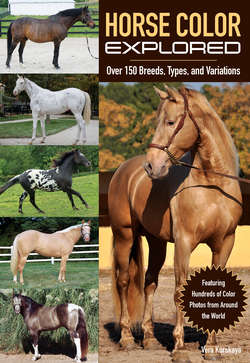Читать книгу Horse Economics - Vera Kurskaya - Страница 28
На сайте Литреса книга снята с продажи.
Smoky Black and Smoky Seal Brown
ОглавлениеIn some countries the smoky black color is not considered its own entity and is not recorded in breeding documents, and rarely is referenced in the literature. Visually this color is difficult or even impossible to distinguish from faded black (see p. 11). Smoky black horses can have smoke-colored hair, and in such cases the shade is uniform over the entire body. The main difference between the smoky black and faded black horse is that in a smoky black animal there is almost no difference between the color of the neck and head. The skin and hooves are pigmented, and the eyes can be a walnut color, causing this color to sometimes be called “yellow-eyed black.”
The smoky black color is on a very rare occasion similar to dark bay or seal brown. In such cases a precise determination of color can be accomplished by an analysis of pedigree data and by performing appropriate DNA tests. For example, if one of the parents of a black horse is double cream (cremello or perlino—see p. 20), then the horse in question must be smoky black. It can also help to study the offspring of the particular horse mated with horses of colors not connected to Cream. If a questionable “black” horse mated with a bay or red produces a buckskin or palomino foal, then the horse must be smoky black. Similar logic would apply if this “black” horse produces a double cream dilute (cremello or perlino) foal.
Smoky black foals are born looking similar to regular black—ashy, sometimes with silvery nuances (Photo 20). Also at a young age they frequently have broad darker bands, which run from the spine parallel to the ribs. The eyes are dark blue and the ears are frequently light inside with black edges. Young smoky black horses can for some period of time acquire dark brown shade. Smoky black horses that have a noticeable dark coffee shade are frequently seen in the Akhal-Teke breed, but this color is also encountered in other breeds carrying the Cream Dilution in their gene pool.
Sponenberg (2009) also mentions a very rare color he refers to as smoky seal brown. This color is most commonly encountered in Morgans and Quarter Horses, although in principle it can be encountered in any breed where the Cream Dilution gene is present. Smoky seal brown horses are visually not different from faded black. Their bodies are almost black but with the expressed red nuances around the muzzle and eyes that are characteristic for seal brown color (see p. 12). The legs as a rule are black. So far the only registry using appropriate names for genetically seal brown horses that are also carriers of dilution genes is the International Champagne Horse Registry (www.ichregistry.com). In almost all other registries, such horses are recorded as brown, dark bay, or black.
